Kaʻiulani
| Kaʻiulani | |||||
|---|---|---|---|---|---|
| Crown Princess of the Hawaiian Islands | |||||
.jpg) | |||||
| Born |
October 16, 1875 Honolulu, Oʻahu, Hawaii, | ||||
| Died |
March 6, 1899 (aged 23) ʻĀinahau, Honolulu, Oahu, Hawaii | ||||
| Burial |
March 12, 1899[1] Royal Mausoleum of Hawaii | ||||
| |||||
| House | Kalākaua | ||||
| Father | Archibald Scott Cleghorn | ||||
| Mother | Princess Miriam Likelike | ||||
| Religion | Church of Hawaii | ||||
| Signature |
| ||||
.svg.png)
Victoria Kawēkiu Kaʻiulani Lunalilo Kalaninuiahilapalapa Cleghorn (October 16, 1875 – March 6, 1899) was heir to the throne of the Kingdom of Hawaii and held the title of Crown Princess. Kaʻiulani became known throughout the world for her intelligence and determination. After the overthrow of the Hawaiian monarchy in 1893, she visited the United States to help restore the Kingdom; she made many speeches and public appearances denouncing the overthrow of her government and the injustice toward her people. While in Washington, D.C., she paid an informal visit to U.S. President Grover Cleveland and First Lady Frances Folsom Cleveland Preston, but her efforts could not prevent eventual annexation.
Heiress to the throne
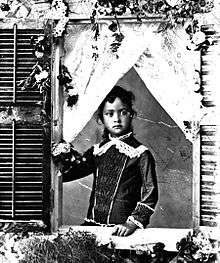
Victoria Kaʻiulani was born October 16, 1875 at Keōua Hale in Honolulu.[4] Through her mother, Kaʻiulani was descended from High Chief Kepoʻokalani, the first cousin of Kamehameha the Great on the side of Kamehameha's mother, Kekuʻiapoiwa II. Her mother was also a sister of King Kalākaua and Queen Liliʻuokalani. Kaʻiulani's father was Archibald Scott Cleghorn, a Scottish financier from Edinburgh and the last Royal Governor of Oʻahu. She was baptized Christmas Day, 1875 at St. Andrew's Anglican Cathedral.[5] Princess Ruth Keʻelikōlani stood as her godmother. Kaʻiulani was named after her maternal aunt Anna Kaʻiulani who died young, and Queen Victoria of the United Kingdom, whose help restored the sovereignty and independence of the Kingdom of Hawaii during the reign of Kamehameha III. The name comes from ka ʻiu lani which means "the highest point of heaven" or "the royal sacred one" in the Hawaiian language.[6] Upon her birth, Kaʻiulani was gifted the estate of ʻĀinahau in Waikiki by her godmother. Kaʻiulani inherited ʻĀinahau at the age of 11 upon the death of her mother.
.jpg)
In 1881, King Kalākaua tried to arrange a marriage between Kaʻiulani and Japan's Prince Higashifushimi Yorihito in hopes of creating an alliance between Japan and the Kingdom of Hawaii. However, the prince declined, as he was already pre-arranged to marry a Japanese noble lady, Arima Yoriko. In 1894, Queen Liliʻuokalani wrote to her niece to marry one of the three: Prince David Kawānanakoa, Prince Jonah Kūhiō Kalanianaʻole, or Prince Komatsu Akihito (then studying in London), the half-brother of Higashifushimi Yorihito. She replied to her aunt that she would prefer to marry for love unless it was necessary to protect the independence of the Hawaiian Kingdom. On February 3, 1898, she declared her engagement to Prince David Kawānanakoa, but her early death ended the hope of marriage.[7]
Education

The Princess grew up knowing painters Joseph Dwight Strong, a landscape painter in the court of her uncle, and Isobel Strong, a lady in waiting under her mother and stepdaughter of Robert Louis Stevenson. Stevenson called her "the island rose" in a poem he wrote in her autograph book.[8] Art and music were also in the curriculum at Great Harrowden Hall, and she took several trips to Scotland and France to study art. Her few surviving paintings demonstrate considerable talent.[9]
Because Princess Kaʻiulani was second in line to the throne after her elderly and childless aunt, the young girl was expected to eventually become Queen. King Kalākaua, Kapiʻolani, Cleghorn, and the Princess talked about the issue and determined the Princess should pursue a British education. In 1889, at the age of 13, Kaʻiulani was sent to Northamptonshire, England to be given a private education at Great Harrowden Hall. She excelled in her studies of Latin, Literature, Mathematics, and History there and took classes in French, German, and sports (mostly tennis and cricket). In 1892, Kaʻiulani made a new start by moving to Brighton where she was chaperoned and tutored by Mrs. Rooke who set up a curriculum including German, French and English. This village by the sea pleased the princess, renewing her enthusiasm.[10] She continued to study in England for the next four years, despite originally being told that she would only be there for one year. Her overseers from Hawaii had planned for her to take a trip around Europe and had even arranged for her to have an audience with Queen Victoria of the United Kingdom. However, following the overthrow of her Aunt, Queen Liliʻuokalani, on January 17, 1893 by local businessmen, all plans were cancelled and she went to New York.
Overthrow
During her absence, much turmoil occurred back in Hawaii. King Kalakaua died in 1891, and Princess Lydia Liliʻuokalani became Queen. Liliʻuokalani immediately appointed Kaʻiulani as her heir, and Kaʻiulani became the Crown Princess. In 1893, the Hawaiian monarchy was overthrown and the new government attempted to become a part of the United States. The news arrived to Kaʻiulani on January 30, 1893 in a short telegram that said: "'Queen Deposed', 'Monarchy Abrogated', 'Break News to Princess'".
Kaʻiulani then made a statement to the press in England:
"Four years ago, at the request of Mr. Thurston, then a Hawaiian Cabinet Minister, I was sent away to England to be educated privately and fitted to the position which by the constitution of Hawaii I was to inherit. For all these years, I have patiently and in exile striven to fit myself for my return this year to my native country. I am now told that Mr. Thurston will be in Washington asking you to take away my flag and my throne. No one tells me even this officially. Have I done anything wrong that this wrong should be done to me and my people? I am coming to Washington to plead for my throne, my nation and my flag. Will not the great American people hear me?"[11]
She referred to Lorrin A. Thurston, who was touring the United States promoting its annexation of Hawaii.[12] Kaʻiulani decided to take action and traveled to the United States herself the following month. Upon arrival on American shores, although shy by nature, she addressed the press in public with these words:
"Seventy years ago, Christian America sent over Christian men and women to give religion and civilization to Hawaii. Today, three of the sons of those missionaries are at your capitol asking you to undo their father’s work. Who sent them? Who gave them the authority to break the Constitution which they swore they would uphold? Today, I, a poor weak girl with not one of my people with me and all these ‘Hawaiian’ statesmen against me, have strength to stand up for the rights of my people. Even now I can hear their wail in my heart and it gives me strength and courage and I am strong – strong in the faith of God, strong in the knowledge that I am right, strong in the strength of seventy million people who in this free land will hear my cry and will refuse to let their flag cover dishonor to mine!"[13]
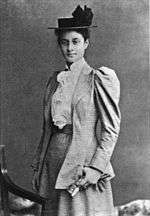
The pro-annexation press of the time often treated Kaʻiulani with contempt, referring to her in print as a half-breed, or calling her "dusky", although she did not receive the blatantly racist treatment repeatedly given her Aunt. (Typical of the time, "positive" accounts of the Princess' appearance often tried to emphasize what was thought to be "white" about her, although her "British" half was invoked negatively on occasion by American writers fearing Great Britain was a rival for possession of Hawaii.) As she traveled across the United States following her education, the real Princess surprised open-minded members of the press. Instead of an unmannered caricature "heathen" described by enemies of the Kingdom of Hawaii, journalists and the public were confronted by a modern royal princess wearing elegant gowns and speaking English (or Hawaiian, French or German). She traveled through New York City and Boston where she attended various social events, many in her honor. She then went to Washington DC and met with President Grover Cleveland and his wife at the White House. She made a good impression, and Cleveland expressed concern for Hawaii's plight. Kaʻiulani felt encouraged something would be done and returned to England. However, when Cleveland brought Kaʻiulani's case to Congress, while the United States Senate did not proceed with annexation, it refused to restore the monarchy. The situation in Hawaii did not improve, and Kaʻiulani was deeply disappointed. Over the next few years, Kaʻiulani remained in Europe. There, she received news in 1894 that her childhood friend, author Robert Louis Stevenson,[14] had died and that a new Republic of Hawaii had been established. Her health slowly deteriorated. Kaʻiulani's health worsened when she learned that her half-sister, Annie Cleghorn, had died in 1897 and her guardian from England, Theophilus Harris Davies, had also died. The Princess suffered eye problems and developed migraines following the overthrow of the monarchy (although one such headache kept her from participating in a charity event in Paris, where a devastating fire killed scores of society women). Numerous documented symptoms may indicate she suffered from thyroid disease, which would help explain her early death.
Later years
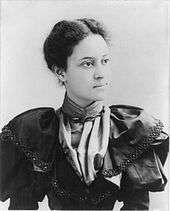
Kaʻiulani returned to Hawaii in 1897. The return to a warmer climate did not help her health. She continued to deteriorate as she struggled to readjust to the tropical climate of the Hawaiian islands. However, she continued to make public appearances at the urging of her father.
With the approval of Queen Liliʻuokalani and Queen Dowager Kapiʻolani and in compliance with the last Hawaiian constitution, Princess Kaʻiulani and Prince Kawānanakoa announced their engagement on February 3, 1898.[15]
She was now a private citizen of the Republic of Hawaii, and on August 12, 1898 became citizen of the Territory of Hawaii as the annexation finally took place. During the Annexation ceremony, the Princess and her aunt, Liliʻuokalani, along with other members of the royal family and with the heads of every Hawaiian political party, wore funeral attire and shuttered themselves within Washington Place, protesting what they considered an illegal transaction. "When the news of Annexation came it was bitterer than death to me," Princess Kaʻiulani, told the San Francisco Chronicle. "It was bad enough to lose the throne, but infinitely worse to have the flag go down..."[16]
Kaʻiulani loved peacocks. She grew up enjoying the company of a flock originally belonging to her mother, and is sometimes called the "Peacock Princess".[17][18]
Death
In 1898, while on a horse ride in the mountains of Hawaii Island, Kaʻiulani was caught in a storm and came down with a fever and pneumonia. Earlier she had caught cold from swimming while on the Big Island, and this worsened matters. Kaʻiulani was brought back to Oahu where her health continued to decline. She died on March 6, 1899 at the age of 23 of inflammatory rheumatism. She was interred in Honolulu's Royal Mausoleum of Hawaii.
Cultural impact
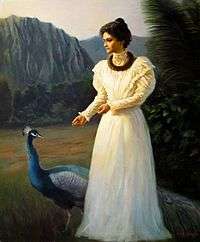
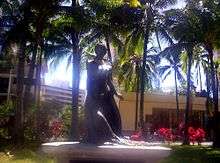
Kaʻiulani has been represented in the music and dance traditions of Hawaii through mele, oli and hula from the time she was born. She continues to inspire generations of Na Kanaka Maoli to traditional forms of honoring her as a beloved Aliʻi.
In the fall of 2007, English filmmaker Marc Forby began production on a $9 million film titled Barbarian Princess based on the princess' attempts to restore her nation's independence. Princess Kaʻiulani was played by 12-year-old Kaimana Paʻaluhi of Oahu and by Q'Orianka Kilcher. Barry Pepper, Will Patton, and Shaun Evans co-star. In March 2008 scenes were filmed on location at the Iolani Palace. The film's world premiere was held at the Hawaii Theatre in Honolulu, Hawaii, on Friday, October 16, 2009, as part of the Hawaii International Film Festival. The film's title provoked controversy, and the film opened with mixed reviews.[19] However, demand to see the film was high and the film festival scheduled several additional screenings. The movie's title has since been changed to Princess Kaiulani.[20] Roadside Attractions acquired the movie's United States rights and scheduled it for theatrical release May 14, 2010.[21]
Forby's film is not the first project to bring the Princess to the screen: well-known Kaʻiulani biographer Kristin Zambucka, working in collaboration with producer Stephanie Spangler, produced a docudrama called "A Cry of Peacocks" for Hawaiian television, released on videocassette in 1994 by Green Glass Productions. Zambucka is rereleasing the film on iTunes.
In March 2017, Hawaiʻi Magazine ranked her among a list of the most influential women in Hawaiian history.[22]
The Kaʻiulani Project
Jennifer Fahrni founded the Kaʻiulani Project to celebrate the life, spirit and legacy of Princess Kaʻiulani. Their goal is to reveal Kaʻiulani as a heroine who fought for her nation in its hour of need, and to serve as a meeting place and reference for other works about the Princess. The project includes Kaʻiulani: The Island Rose, a fact-based screenplay and stage play researched and written since 2003 by Fahrni and Carol Harvie-Yamaguchi, and a biography Princess Ka'iulani – Her Life and Times. The script was first performed as a public reading April 12, 2008 in Kahului, Hawaii on Maui.[23]
Honorary position
- Honorary Vice-President of the Hawaiian Red Cross Society.[24]
Ancestry
Kalākaua family tree |
|---|
|
Key- (k)= Kane (male/husband) |
| Ancestors of Kaʻiulani | ||||||||||||||||||||||||||||||||||||||||||||||||||||||||||||||||||||||||||||||||||||||||||||||||||||||||||||||||||||||||||||||||||||||||||||||||||||||||||||||||||||||||||||||||||||||||||||||||||||||||||||||||||||||||||||||||||||||||||||||||||||||||||||||||||||||||||||||||||||||||||||||||||||||||||||||||||||||||||||||||||||||||||||||||||||||||||||||||||||||||||||||||||||||||||||||||||||||||||||||||||||||||||||||||||||||||||||||||||||||||||||||||||||||||||||||||||||||||||||||||||||||||||||||||||||||||||||||||||||||||||||||||||||||||||||||||||||||||||||||||||||||||||||||||
|---|---|---|---|---|---|---|---|---|---|---|---|---|---|---|---|---|---|---|---|---|---|---|---|---|---|---|---|---|---|---|---|---|---|---|---|---|---|---|---|---|---|---|---|---|---|---|---|---|---|---|---|---|---|---|---|---|---|---|---|---|---|---|---|---|---|---|---|---|---|---|---|---|---|---|---|---|---|---|---|---|---|---|---|---|---|---|---|---|---|---|---|---|---|---|---|---|---|---|---|---|---|---|---|---|---|---|---|---|---|---|---|---|---|---|---|---|---|---|---|---|---|---|---|---|---|---|---|---|---|---|---|---|---|---|---|---|---|---|---|---|---|---|---|---|---|---|---|---|---|---|---|---|---|---|---|---|---|---|---|---|---|---|---|---|---|---|---|---|---|---|---|---|---|---|---|---|---|---|---|---|---|---|---|---|---|---|---|---|---|---|---|---|---|---|---|---|---|---|---|---|---|---|---|---|---|---|---|---|---|---|---|---|---|---|---|---|---|---|---|---|---|---|---|---|---|---|---|---|---|---|---|---|---|---|---|---|---|---|---|---|---|---|---|---|---|---|---|---|---|---|---|---|---|---|---|---|---|---|---|---|---|---|---|---|---|---|---|---|---|---|---|---|---|---|---|---|---|---|---|---|---|---|---|---|---|---|---|---|---|---|---|---|---|---|---|---|---|---|---|---|---|---|---|---|---|---|---|---|---|---|---|---|---|---|---|---|---|---|---|---|---|---|---|---|---|---|---|---|---|---|---|---|---|---|---|---|---|---|---|---|---|---|---|---|---|---|---|---|---|---|---|---|---|---|---|---|---|---|---|---|---|---|---|---|---|---|---|---|---|---|---|---|---|---|---|---|---|---|---|---|---|---|---|---|---|---|---|---|---|---|---|---|---|---|---|---|---|---|---|---|---|---|---|---|---|---|---|---|---|---|---|---|---|---|---|---|---|---|---|---|---|---|---|---|---|---|---|---|---|---|---|---|---|---|---|---|---|---|---|---|---|---|---|---|---|---|---|---|---|---|---|---|---|---|---|---|---|---|---|---|---|---|---|---|---|---|---|---|---|---|---|---|---|---|---|---|---|---|---|---|---|---|---|---|---|---|---|---|---|---|---|---|---|---|---|---|---|---|---|---|---|---|---|---|---|---|---|---|---|---|---|---|---|---|---|---|---|---|---|---|---|---|---|---|---|---|---|---|---|---|---|---|---|---|---|---|---|---|---|---|---|---|---|---|---|---|---|---|---|---|---|---|---|---|---|---|---|---|---|---|---|---|---|---|---|---|---|---|---|---|---|---|---|---|---|---|
| ||||||||||||||||||||||||||||||||||||||||||||||||||||||||||||||||||||||||||||||||||||||||||||||||||||||||||||||||||||||||||||||||||||||||||||||||||||||||||||||||||||||||||||||||||||||||||||||||||||||||||||||||||||||||||||||||||||||||||||||||||||||||||||||||||||||||||||||||||||||||||||||||||||||||||||||||||||||||||||||||||||||||||||||||||||||||||||||||||||||||||||||||||||||||||||||||||||||||||||||||||||||||||||||||||||||||||||||||||||||||||||||||||||||||||||||||||||||||||||||||||||||||||||||||||||||||||||||||||||||||||||||||||||||||||||||||||||||||||||||||||||||||||||||||
References
- ↑ Forbes 2003, pp. 736–737.
- ↑ Webb & Webb 1998, p. 83.
- ↑ Liliuokalani 1898, p. 219.
- ↑ Royal Ark
- ↑ Ralph S. Kuykendall (1967). Hawaiian Kingdom 1874–1893, the Kalakaua Dynastism. University of Hawaii Press. p. 477. ISBN 978-0-87022-433-1.
- ↑ Mary Kawena Pukui and Samuel Hoyt Elbert (2003). "lookup of ʻiu". in Hawaiian Dictionary. Ulukau, the Hawaiian Electronic Library, University of Hawaii Press.
- ↑ "PRINCESS KAIULANI ENGAGED.; To Wed Prince David Kawananakoa of Hawaiian Royal Blood" (PDF). The New York Times. February 12, 1898.
- ↑ Janet Hulstrand (May 8, 2009). "Ka'iulani: Hawaii's Island Rose". Smithsonian Magazine. Smithsonian Institution. Retrieved 2007-08-31.
- ↑ Don R. Severson (2002). Finding Paradise, Island Art in Private Collections. University of Hawaii Press. pp. 85–87.
- ↑ "Princess Kaiulani, Her Life and Times". Princess Ka'iulani Project web site. Princess Kaʻiulani Project USA.
- ↑ Stassen-McLaughlin 1999, p. 35.
- ↑ Ralph S. Kuykendall (1967). Hawaiian Kingdom 1874–1893: the Kalakaua Dynasty. University of Hawaii Press. p. 115. ISBN 978-0-87022-433-1.
- ↑ "Princess Kaiulani". Women in history of Scots descent web site. Electric Scotland USA.
- ↑ Arthur Johnstone (1905). Recollections of Robert Louis Stevenson in the Pacific. Chatto & Windus.
- ↑ "Princess Kaiulani Engaged; to wed Prince David Kawananakoa of Royal Hawaiian Blood" (PDF). New York Times archives. February 12, 1898.
- ↑ Michael Tighe (August 9, 1998). "Hawaii's Own: A look at a century of annexation". Associated Press. Retrieved 2010-03-30.
- ↑ Nelson Daranciang (February 2, 2007). "Isle man claims cabinet is a royal find: He thinks Ka'iulani owned it, and it's on eBay for $6.5 million". Honolulu Star-Bulletin.
- ↑ Will Hoover (July 2, 2006). "Princess Ka'iulani". The Honolulu Advertiser.
- ↑ Michael Tsai (October 17, 2009). "Ka'iulani film met with applause, disappointment". The Honolulu Advertiser. Archived from the original on October 21, 2009. Retrieved 2009-10-22.
- ↑ Kaʻiulani on IMDb
- ↑ "Roadside drawn to Hawaiian biopic Princess Kaiulani: Roadside Attractions has acquired all US rights to Marc Forby's Hawaiian historical biopic Princess Kaiulani". Screen Daily. February 10, 2010. Retrieved May 7, 2010.
- ↑ Dekneef, Matthew (March 8, 2017). "15 extraordinary Hawaii women who inspire us all. We can all learn something from these historic figures". Hawaiʻi Magazine. Honolulu. Archived from the original on March 8, 2017. Retrieved May 7, 2017.
- ↑ Jennifer Fahrni (2008). "The Ka'iulani Project". Retrieved December 25, 2010.
- ↑ "KAUAI". royalark.net. Retrieved 28 February 2015.
Bibliography
- Askman, Douglas V. (2008). "Her Majesty's Disloyal Opposition: An Examination of the English-Language Version of Robert Wilcox's the Liberal, 1892–1893". The Hawaiian Journal of History. Honolulu: Hawaiian Historical Society. 42: 177–200. hdl:10524/135. OCLC 60626541.
- Askman, Douglas V. (2013). "Royal Standards of the Kingdom of Hawai'i, 1837–1893". The Hawaiian Journal of History. Honolulu: Hawaiian Historical Society. 47: 61–86. hdl:10524/36268. OCLC 60626541.
- Andrade, Ernest Jr. (1990). "Great Britain and the Hawaiian Revolution and Republic, 1893–1898". The Hawaiian Journal of History. Honolulu: Hawaiian Historical Society. 24: 91–116. hdl:10524/562. OCLC 60626541.
- Cleghorn, Thomas A. K.; Cleghorn, Nellie Yarnell Maxwell; Argow, Dorothy; Allen, Katherine B. (1979). "Thomas Alexander Kaulaahi Cleghorn". The Watumull Foundation, Oral History Project. Honolulu: The Watumull Foundation, Oral History Project: 1–82. hdl:10524/48595. OCLC 10006035.
- Forbes, David W., ed. (2003). Hawaiian National Bibliography, 1780–1900, Volume 4: 1881–1900. 4. Honolulu: University of Hawaii Press. ISBN 978-0-8248-2636-9. OCLC 123279964.
- Kam, Ralph Thomas (2017). Death Rites and Hawaiian Royalty: Funerary Practices in the Kamehameha and Kalakaua Dynasties, 1819–1953. S. I.: McFarland, Incorporated, Publishers. ISBN 978-1-4766-6846-8. OCLC 966566652.
- Kam, Ralph Thomas (2011). "The Legacy of ʻĀinahau: The Genealogy of Kaʻiulani's Banyan". The Hawaiian Journal of History. Honolulu: Hawaiian Historical Society. 45: 49–68. hdl:10524/33781. OCLC 60626541.
- Liliuokalani (1898). Hawaii's Story by Hawaii's Queen, Liliuokalani. Boston: Lee and Shepard. ISBN 978-0-548-22265-2. OCLC 2387226.
- Linnea, Sharon (1999). Princess Kaʻiulani: Hope of a Nation, Heart of a People. Grand Rapids, MI: Eerdmans Young Readers. ISBN 978-0-8028-5088-1. OCLC 36727806.
- Mcdermott, John F.; Choy, Zita Cup; Guerrero, Anthony P. S. (2015). "The Last Illness and Death of Hawaiʻi's King Kalākaua: A New Historical/Clinical Perspective Cover". The Hawaiian Journal of History. Honolulu: Hawaiian Historical Society. 49: 59–72. OCLC 60626541 – via Project MUSE.
- Stassen-McLaughlin, Marilyn (1999). "Unlucky Star – Princess Kaʻiulani". The Hawaiian Journal of History. Honolulu: Hawaiian Historical Society. 33: 21–54. hdl:10524/450. OCLC 60626541.
- Webb, Nancy; Webb, Jean Francis (1998). Kaiulani: Crown Princess of Hawaii. Honolulu: Mutual Publishing. ISBN 978-1-56647-206-7. OCLC 265217757.
Further reading
- Powell, Ruth Bancroft (1954). Princess Kaiulani: The Hope of Hawaii. Honolulu. OCLC 16333159.
- Stanley, Fay (2001). The Last Princess: The Story of Princess Ka'iulani of Hawai'i. New York: HarperCollins. ISBN 978-0-688-18020-1. OCLC 44039887.
- Webb, Nancy; Webb, Jean Francis (1962). Kaiulani: Crown Princess of Hawaii. New York: Viking Press. OCLC 1231662.
- White, Ellen Emerson (2001). Kaiulani: The People's Princess. New York: Scholastic Inc. ISBN 978-0-439-12909-1. OCLC 1022896056.
- Woodrum, Dorothea (1964). Governor Cleghorn, Princess Kaiulani and Ainahau: Recollections of a Gracious Era in Hawaii's History. Honolulu: Island Development Corporation. OCLC 15498409.
- Zambucka, Kristin (1982). Princess Kaiulani: The Last Hope of Hawaii's Monarchy. Honolulu: Mana Publishing Company. ISBN 978-0-935038-02-6. OCLC 317985311.
- Zambucka, Kristin (1998). Princess Ka'iulani of Hawaiʻi: The Monarchy's Last Hope. Honolulu: Mutual Publishing. ISBN 978-1-56647-710-9. OCLC 149442849.
External links
| Wikimedia Commons has media related to Kaʻiulani. |
- Princess Ka'iulani, Rose of Two Worlds by Mindi Reid
- Ka'iulani – The Island Rose
- Kaiulani:The Hope of the People
- Princess Ka‘iulani
- Princess Victoria Ka'iulani Cleghorn (1875–1899)
- Kimon Iannetta. "Behavioral Profiling Through Written Communication: Profile of An Hawaiian Princess". Archived from the original on 2010-10-07. Retrieved 2010-03-30. (Analysis of her handwriting)
- Victoria Ka'iulani, An Icon of Two Selves, by Mindi Reid
- Hana Hou Kaiulani
- Kaʻiulani at Find a Grave
- Princess Ka'ilulani (2009) dramatic film on the Internet Movie Database